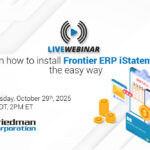
For make-to-order and custom manufacturers, shipping costs can greatly affect profits. This is especially true when using Less-Than-Truckload (LTL) freight services. Savings could be on the horizon for your business! The National Motor Freight Traffic Association (NMFTA) recently proposed changes to LTL freight classification shipping rules.
These changes aim to update freight class rules. This will make pricing more predictable and lower rates for shipments that meet new density-based classifications. Manufacturers must ensure accurate freight classifications to maximize these cost savings. They should consider optimizing their shipping processes and improving palletization with Frontier ERP for even greater savings.
Understanding the NMFTA’s Freight Classification System
The National Motor Freight Classification (NMFC) system, governed by the NMFTA, categorizes freight into different classes based on four key factors:
- Density – The weight-to-volume ratio of a shipment.
- Stowability – How easily the freight fits within standard shipping containers.
- Handling – The level of difficulty in transporting the freight.
- Liability – The risk of damage, theft, or loss.
Freight classes range from Class 50 (least expensive, dense items) to Class 500 (most expensive, light and bulky items). The higher the class, the more expensive the shipping rate per hundredweight (CWT).
What are the Proposed LTL Freight Classification Changes?
Historically, certain products were classified based on their commodity type. That led to inconsistent pricing structures for manufacturers shipping similar goods. The NMFC will shift to a density-based scale to simplify the classification for loads that have no handling, stowability, or liability issues.
These changes would:
✅ Lower Freight Classes for Heavier Shipments: High-density products such as metal components, furniture, cabinetry, glass panels, and other custom-manufactured goods could qualify for lower freight classes, reducing shipping costs.
✅ Standardize Classification Rules: Simplified classification could make LTL freight pricing more predictable and reduce administrative complexity.
✅ Encourage Better Packaging and Pallet Stacking: Manufacturers can cut costs by optimizing packaging and stacking. This can help their shipments qualify for lower freight classes.
For custom manufacturers, these LTL freight classification changes could result in significant freight savings. However, don’t drag your heels to get started on your new classification process. A Supply Chain Dive article on the subject notes, “Initially scheduled for May, the long-discussed changes were postponed until July 19 to allow the industry more preparation time.”
UPDATE: FedEx Freight delays LTL classification enforcement. Read more here.
For more details on the NMFTA and changing LTL freight classifications, click here.
How Will Custom Manufacturers Benefit?
Lower Freight Costs for Heavier, Compact Shipments
LTL freight classification is changing to support denser shipments. Custom manufacturers that send heavier assembled or semi-assembled products will gain the most benefits. These manufacturers often face higher freight classes due to bulkiness. “The move to 13 freight classes from the 11 existing classes could allow shippers with heavy, dense freight to lower their rates by shifting it to a lower class,” SMC3 Chief Commercial Officer Brian Thompson said.
More Accurate and Fair Freight Pricing
Manufacturers are no longer punished for shipping high-value, customized products. They can now gain from a system that rewards good packing and shipping practices. This means:
- Fewer unexpected freight reclassifications that lead to additional charges.
- Greater pricing transparency when quoting freight costs for customers.
- Easier logistics planning with more predictable costs.
Less Administrative Hassle
LTL freight classification updates will simplify certain NMFC codes. Therefore, custom manufacturers that ship diverse products will have fewer classification disputes with carriers. This reduces billing errors, reclassification fees, and unnecessary administrative burdens.
Optimizing LTL Freight Shipping with Frontier ERP
To fully capitalize on these changes, manufacturers need an ERP system with strong logistics and shipping management tools. Frontier ERP provides essential features to streamline LTL shipping, optimize freight classification, and minimize costs.

Frontier ERP’s centralized database contains all LTL freight classifications and product and packaging specifications for easier logistics planning.
Frontier’s iDispatch is a web-based tool for shipment planning and execution. It supports all shipping modes, including LTL. It uses the Frontier configurator to create important shipment details determining the freight class. These details help improve daily load planning.
1. Customizable Setup for Truckload Shipping
iDispatch includes a user-definable setup tool, allowing schedulers to configure truckload shipping parameters. Adjustable variables—such as trailer capacity and deliveries per load—help optimize efficiency and streamline logistics.
2. Stop Planning Integration
Integrated with stop-planning software like PC*Miler, iDispatch provides a smooth interface for load and route planning. This connection enables schedulers to generate consolidated load lists, ensuring a well-organized pick and load process.
3. Manufacturing Sequencing Synchronization
iDispatch works with Frontier iSchedule to align manufacturing sequencing with truckload planning. By syncing run rules and sequencing, manufacturers can make sure products are ready when shipments are scheduled. This reduces downtime and increases throughput.
4. Palletization & Load Optimization
Determine the best way to stack and palletize shipments for maximum density and lower freight shipping class ratings through iDispatch. This reduces wasted space, improves stowability, and prevents costly dimensional weight surcharges from carriers.
5. Bill of Lading (BOL) & Compliance Automation
Frontier automatically generates BOLs that reflect the correct NMFC classification. This improves efficiency in freight documentation and shipment tracking. It also reduces disputes with carriers by ensuring accurate weight and density calculations.
6. Multi-Warehouse Shipping Management
With Frontier, you can easily ship from multiple distribution centers for shorter transit distances and lower freight rates. Plus, you gain the benefit of automated order fulfillment based on location and LTL cost efficiency.
7. Seamless Carrier Integration
You can access real-time tracking, classification updates, and cost analysis for LTL freight carriers through Frontier iDispatch. Frontier also helps ensure compliance with new NMFTA freight classification rules through automatic updates.
Gain More Savings and Efficiency with Varsity Logistics Integration

Let Frontier ERP and our partner, Varsity Logistics, help you with your LTL freight classification needs for NFMTA compliance.
Do you need more shipping assistance? We suggest Varsity Logistics, our partner for transportation management. They can help you improve your LTL shipping operations and save you even more money. Here’s how Varsity can assist:
- Frontier ERP Integration: Varsity Logistics uses an IBM platform for the best performance. It integrates seamlessly with Frontier ERP and other IBM systems. Integration allows for seamless order processing, inventory management, and shipping coordination.
- LTL Rate Shopping and Optimization: Varsity’s Transportation Management System allows you to compare rates from multiple LTL carriers. This ensures they get the best pricing based on shipment weight, dimensions, and destination.
- Carrier Selection and Booking: With automated carrier selection, you can choose the most cost-effective and efficient LTL carrier for each shipment. The system considers factors like transit time, cost, and service levels to make recommendations.
- Freight Consolidation: Varsity’s software can analyze multiple small shipments and consolidate them into fewer LTL shipments. This is particularly useful for manufacturers with frequent small-batch shipments.
- Automated Bill of Lading (BOL) and Label Generation: Varsity’s TMS can generate BOLs, shipping labels, and other required documents automatically. By reducing manual data entry it saves time and increases accuracy.
- Real-Time Tracking and Visibility: Varsity’s tracking tools provide real-time visibility. That way, you can monitor LTL shipments in transit for potential shipping delays.
- Freight Audit and Cost Control: Validate freight invoices, flag discrepancies, and ensure you aren’t overpaying with software from Varsity.
Final Thoughts: Take Control of Your LTL Shipping Costs
With NMFTA refining LTL freight classifications, custom manufacturers can stay ahead of the curve by leveraging the right technology. Frontier and Varsity’s shipping and logistics tools provide the control, automation, and optimization needed to reduce freight costs today.
Want to learn how we can improve your shipping strategy? Contact us today to learn more!






